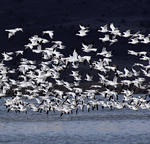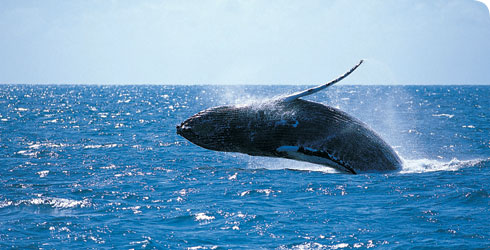Animal migration
'Migration is one of the great wonders of the natural world. This fascinating phenomenon takes many forms and is much more than a simple trip from A to B,' says Ben Hoare, author of the Museum book Animal Migration. Ben explains more below.
What is migration?
Is it the nomadic wandering of kangaroos in the Australian outback? Or a puffin’s fishing expeditions to find food for its chick? And what about the journey an earthworm makes to the surface of the soil and back again?
You could say that migration is a journey with a clear purpose from one area to another, often following a well-defined route to a familiar destination, and often at a specific season or time.

Flock of snow geese
But the reality is that there is no universally accepted definition of migration and it is not always easy to decide which are true migrations.
The problem is that animals carry out all kinds of different movements – short and long, seasonal and daily, regular and once-in-a-lifetime, highly predictable and seemingly random.
Why do animals migrate?
If one thing unites all migratory species, it is the fight to survive. Migration enables them to spend their life in two or more different areas, usually because lack of food makes it impossible to stay in the same place.
Other reasons animals migrate:
- to find essential minerals eg wildebeest, African elephant
- to find shelter or avoid harsh winter weather eg Mexican free-tailed bat, red-sided garter snake, monarch butterfly, Caribbean spiny lobster
- to search for a mate eg male sperm whale, Australian giant cuttlefish
- to give birth, lay eggs or raise young eg grey whale, European toad, green turtle, emperor penguin
- to moult in a safe place eg walrus, shelduck, yellow-lipped sea krait (a venomous sea snake)
- to flee overcrowded conditions eg Norway lemming, desert locust
Types of migration
The classic idea of migration is birds flying north and south between separate summer and winter ranges, or whales travelling to faraway feeding or birthing grounds.
There are many others types of migration, including:
- east–west journeys
- circuits of the land and ocean
- trips up and down mountains
- vertical movements through the water column of seas and lakes
Members of the same species may follow a variety of different routes. And in some migrations, only one sex or part of a species’ population is involved.
Finding the way
Animals have evolved highly efficient direction-finding systems. This enables them to steer the right course over great distances, often with astonishing accuracy.

Monarch butterfly breaks the record for longest insect migration
Visual clues can play a central role. They include looking out for familiar geographical landmarks, and orientating by the Sun and stars. Patterns of polarised light in the sky are important, too.
Non-visual clues used in orientation include smells, tastes and sounds. Aquatic animals can analyse subtle changes in water quality and 'read' wave and current patterns. Most remarkable of all is the ability to orientate by sensing tiny variations in the Earth’s magnetic field.
Surviving the journey
Migration is not as dangerous as you might expect. It is a means of staying alive, after all. Migratory animals have evolved lots of ways to reduce the risks, such as:
- travel in groups for protection
- hitch a lift on ocean currents, favourable winds or rising currents of warm air called thermals
- stop en route to rest and refuel
- feed intensively before setting off to lay down fat reserves as fuel – a form of behaviour called hyperphagia
- radical physical transformation. Some birds develop larger, more powerful breast muscles that are used in flight and shrink non-essential organs – otherwise they would be too heavy.
Some record migrations
- The longest insect migration is the monarch butterfly. It travels up to 4,750km in the autumn.
- The rarest migrant is the Amsterdam albatross. There are only 70-80 adults in the world.
- The largest migrant is the blue whale. It reaches a length of 24-27m.
- The longest recorded journey in water is a leatherback turtle, which travelled 20,558km in 647 days.
- The highest migration is the bar-headed goose that can reach up to 9,000m altitude.
Toolbox

In 2003 nearly 12,000 scientists from over 60 countries came to work at the Museum.
